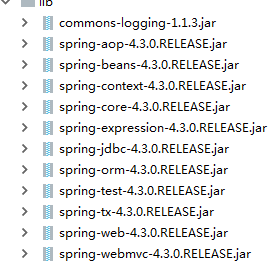IOC和DI
IOC(控制反转 Inversion of control)很抽象的概念,是一种设计思想,在spring中可以先简单的理解为将对象的创建,赋值等交给spring工厂进行.
DI(依赖注入 dependency injection)控制反转有一种方式叫做 依赖注入,A如果依赖B,A此时并不需要创建B,也不用关心B如何创建的,spring会在适合的时候将B创建出来注入到A中。
简单了解一下工厂模式
下面写了一个小demo

a1.properties 是一个文本文件,里面通过键值的方式放入我们需要的数据
key值自己定义,value值是要创建的对象的类

其中factory包下的BeanFactory就是要写的一个工厂类,直接先看代码然后解释
public class BeanFactory{
//先创建Properties对象
private static Properties pro = new Properties();
//在静态代码块里面读取a1.properties里面的内容
static {
//静态代码块中的代码要进行try catch处理
try {
//将properties文件里面的内容读取进入一个流中
InputStream in = BeanFactory.class.getResourceAsStream("/a1.properties");
//用properties对象从输入流中读取
pro.load(in);
} catch (Exception e){
e.printStackTrace();
}
//创建对象的方法
public static Object getBean(String key){
//通过反射机制创建对象
Class clz = Class.forName(pro.getProperty(key));
return clz.newInstance();
}
}
}
//创建一个测试类
public class TestBeanFactory{
public static void main(String[] args) {
//调用工厂类创建对象
UserDao dao=(UserDao)BeanFactory.getBean("userDao");
//调用dao中的方法
dao.insert();
}
}
接下来就看一下 Spring怎么创建对象的吧
1.添加jar包 为了省事,我将spring的初始学习的jar全部导入了

2.需要一个xml配置文件,本例名字是applicationContext.xml
<?xml version="1.0" encoding="UTF-8"?>
<beans xmlns="http://www.springframework.org/schema/beans"
xmlns:xsi="http://www.w3.org/2001/XMLSchema-instance"
xsi:schemaLocation="http://www.springframework.org/schema/beans
http://www.springframework.org/schema/beans/spring-beans.xsd">
<!--在这里写上要创建的对象
1d:这个bean标签的唯一标识,自己起的名字不要重复就好
class:要创建对象的类全路径
-->
<bean id="userService" class="com.service.impl.UserServiceImpl"></bean>
</beans>
3.测试一下
public class TestSpring{
public static void main(String[] args) {
//创建spring的工厂的对象
ClassPathXmlApplicationContext ac=new ClassPathXmlApplicationContext("classpath:applicationContext.xml");
//参数就是配置文件里面 对应bean的id值
UserService us=(UserService)ac.getBean("userService");
}
}
属性注入
这个直接上代码了
Person类
private int id;
private String name;
private List<String> list;
private Properties pro;
//set get 方法
配置文件:
<bean id="person" class="com.entity.Person">
<!--给基本类型赋值 int-->
<property name="id" value="101"></property>
<!--给String类型赋值-->
<property name="name" value="张三"></property>
<!--给list集合类型赋值-->
<property name="list">
<list>
<value>哈哈</value>
<value>呵呵</value>
<value>嘿嘿</value>
</list>
</property>
<!--给properties类型赋值-->
<property name="pro">
<props>
<prop key="a1">哈哈</prop>
<prop key="a2">呵呵</prop>
<prop key="a3">嘿嘿</prop>
</props>
</property>
</bean>
构造注入
User类里面要加一个有参构造方法
private String username;
public User(String name){
this.name=name;
}
配置文件:
<bean id="user" class="com.entity.User">
<!--name属性是User类里面的属性名称
也可以是index 代表有参构造中方法的顺序
还有type等....
-->
<constructor-arg name="username" value="张三"></constructor-arg>
</bean>